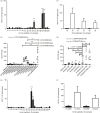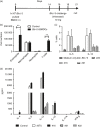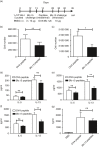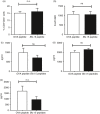Blomia tropicalis allergen 5 (Blo t 5) T-cell epitopes and their ability to suppress the allergic immune response
- PMID: 28581024
- PMCID: PMC5588770
- DOI: 10.1111/imm.12772
Blomia tropicalis allergen 5 (Blo t 5) T-cell epitopes and their ability to suppress the allergic immune response
Erratum in
-
Corrigendum.Immunology. 2018 Mar;153(3):397. doi: 10.1111/imm.12875. Immunology. 2018. PMID: 29392768 Free PMC article. No abstract available.
Abstract
Blomia tropicalis is the major asthma allergen in the tropics comparable to Dermatophagoides pteronyssinus. However, little is known about the B. tropicalis epitopes recognized by T cells. Our aim was to identify the T-cell epitopes in the major B. tropicalis allergen, Blo t 5, and investigate the potential of the corresponding peptides to inhibit the allergic inflammatory lung response. C57BL/6 mice were immunized with plasmid DNA encoding Blo t 5 and T-cell epitopes identified using the interferon-γ ELISPOT assay with 15-mer overlapping peptides. C57BL/6 mice were sensitized with bone-marrow-derived dendritic cells (BMDC) pulsed with Blo t 5 allergen followed by intranasal Blo t 5 challenge. Two H-2b restricted epitopes (Bt576-90 and Bt5106-115 ) were recognized by CD4 T cells specific for Blo t 5, but no CD8 epitopes were identified. In mice sensitized with Blo t 5-pulsed BMDC and challenged with intranasal Blo t 5 Bt576-90 and Bt5106-115 , peptide-specific CD4 T cells were found to secrete the T helper type 2 cytokines interleukin-5 and interleukin-13. Intradermal administration of synthetic peptides encoding the identified T-cell epitopes suppressed allergic airway inflammation to further allergen challenges. Hence, we have identified novel CD4 T-cell epitopes specific for Blo t 5 and demonstrated that these peptides could be employed therapeutically to suppress the T-cell response in a murine model of allergic airway inflammation.
Keywords: Allergy; Blomia tropicalis; DNA vaccine; mouse model.
© 2017 John Wiley & Sons Ltd.
Figures






Similar articles
-
Characterization of a hybrid protein designed with segments of allergens from Blomia tropicalis and Dermatophagoides pteronyssinus.Immunol Lett. 2018 Apr;196:103-112. doi: 10.1016/j.imlet.2018.01.012. Epub 2018 Feb 3. Immunol Lett. 2018. PMID: 29408409
-
Cross-Reactivity between Major IgE Epitopes of Family 5 Allergens from Dermatophagoides pteronyssinus and Blomia tropicalis.Int Arch Allergy Immunol. 2019;178(1):10-18. doi: 10.1159/000492871. Epub 2018 Oct 31. Int Arch Allergy Immunol. 2019. PMID: 30380546
-
Generation of monoclonal antibodies against Blo t 3 using DNA immunization with in vivo electroporation.Clin Exp Allergy. 2003 May;33(5):663-8. doi: 10.1046/j.1365-2222.2003.01648.x. Clin Exp Allergy. 2003. PMID: 12752596
-
Blomia tropicalis: A 50-Year History.J Allergy Clin Immunol Pract. 2025 Jun;13(6):1289-1297. doi: 10.1016/j.jaip.2024.11.007. Epub 2024 Nov 20. J Allergy Clin Immunol Pract. 2025. PMID: 39577660 Review.
-
Molecular cloning of Blomia tropicalis allergens--a major source of dust mite allergens in the tropics and subtropics.Inflamm Allergy Drug Targets. 2006 Dec;5(4):261-6. doi: 10.2174/187152806779010954. Inflamm Allergy Drug Targets. 2006. PMID: 17168798 Review.
Cited by
-
To stay or not to stay intact as an allergen: the endolysosomal degradation assay used as tool to analyze protein immunogenicity and T cell epitopes.Front Allergy. 2024 Jul 12;5:1440360. doi: 10.3389/falgy.2024.1440360. eCollection 2024. Front Allergy. 2024. PMID: 39071040 Free PMC article. Review.
-
Storage Mite Precision Allergy Molecular Diagnosis in the Moderate-to-Severe T2-High Asthma Phenotype.Int J Mol Sci. 2022 Apr 13;23(8):4297. doi: 10.3390/ijms23084297. Int J Mol Sci. 2022. PMID: 35457116 Free PMC article.
-
A hybrid of two major Blomia tropicalis allergens as an allergy vaccine candidate.Clin Exp Allergy. 2020 Jul;50(7):835-847. doi: 10.1111/cea.13611. Epub 2020 May 13. Clin Exp Allergy. 2020. PMID: 32314444 Free PMC article.
-
Corrigendum.Immunology. 2018 Mar;153(3):397. doi: 10.1111/imm.12875. Immunology. 2018. PMID: 29392768 Free PMC article. No abstract available.
-
Molecular Mapping of Allergen Exposome among Different Atopic Phenotypes.Int J Mol Sci. 2023 Jun 21;24(13):10467. doi: 10.3390/ijms241310467. Int J Mol Sci. 2023. PMID: 37445644 Free PMC article.
References
-
- Yeoh SM, Kuo IC, Wang DY, Liam CK, Sam CK, de Bruyne JA et al Sensitization profiles of Malaysian and Singaporean subjects to allergens from Dermatophagoides pteronyssinus and Blomia tropicalis . Int Arch Allergy Immunol 2003; 132:215–20. - PubMed
-
- Arruda LK, Vailes LD, Platts‐Mills TA, Fernandez‐Caldas E, Montealegre F, Lin KL et al Sensitization to Blomia tropicalis in patients with asthma and identification of allergen Blo t 5. Am J Respir Crit Care Med 1997; 155:343–50. - PubMed
-
- Yi FC, Cheong N, Shek LP, Wang DY, Chua KY, Lee BW. Identification of shared and unique immunoglobulin E epitopes of the highly conserved tropomyosins in Blomia tropicalis and Dermatophagoides pteronyssinus . Clin Exp Allergy 2002; 32:1203–10. - PubMed
-
- Simpson A, Green R, Custovic A, Woodcock A, Arruda LK, Chapman MD. Skin test reactivity to natural and recombinant Blomia and Dermatophagoides spp. allergens among mite allergic patients in the UK. Allergy 2003; 58:53–6. - PubMed
-
- Kuo IC, Cheong N, Trakultivakorn M, Lee BW, Chua KY. An extensive study of human IgE cross‐reactivity of Blo t 5 and Der p 5. J Allergy Clin Immunol 2003; 111:603–9. - PubMed
Publication types
MeSH terms
Substances
Associated data
- Actions
- Actions
LinkOut - more resources
Full Text Sources
Other Literature Sources
Medical
Molecular Biology Databases
Research Materials
Miscellaneous

